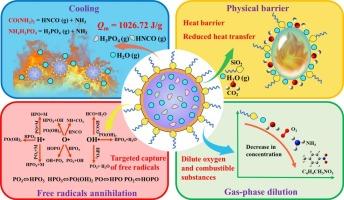Mechanistic insights into the suppression of p-nitrotoluene explosions by a novel urea–NH4H2PO4 modified dry water powder
IF 4.6
2区 工程技术
Q2 ENGINEERING, CHEMICAL
引用次数: 0
Abstract
A novel urea-NH4H2PO4 modified dry water powder (U![]() N MDW powder) was developed to mitigate dust explosions induced by p-nitrotoluene. The explosion suppression performance of the U
N MDW powder) was developed to mitigate dust explosions induced by p-nitrotoluene. The explosion suppression performance of the U![]() N MDW powder was assessed using both experiments and numerical simulations. Suppression experiments were conducted in a 120 L explosion vessel with p-nitrotoluene powder. Results showed that a concentration of 500 g/m3 of U
N MDW powder was assessed using both experiments and numerical simulations. Suppression experiments were conducted in a 120 L explosion vessel with p-nitrotoluene powder. Results showed that a concentration of 500 g/m3 of U![]() N MDW powder could completely suppress the explosion. ReaxFF molecular dynamics and reaction kinetics simulations demonstrated that U
N MDW powder could completely suppress the explosion. ReaxFF molecular dynamics and reaction kinetics simulations demonstrated that U![]() N MDW powder suppressed the rapid cleavage of nitro and methyl groups in p-nitrotoluene molecules. It also suppressed oxidative ring-opening pathways in the benzene ring. This disruption weakened the chain reaction mechanism underlying the decomposition of p-nitrotoluene. The decomposition products of U
N MDW powder suppressed the rapid cleavage of nitro and methyl groups in p-nitrotoluene molecules. It also suppressed oxidative ring-opening pathways in the benzene ring. This disruption weakened the chain reaction mechanism underlying the decomposition of p-nitrotoluene. The decomposition products of U![]() N MDW powder effectively scavenged key radicals involved in the explosion process. Through catalytic cyclic reactions (PO⇔HPO, PO2⇔HOPO, PO3⇔HPO3, and HPO3⇔PO(OH)2), these products continuously quenched radicals that sustain flame propagation or converted them into stable species such as CO2 and H2O. The U
N MDW powder effectively scavenged key radicals involved in the explosion process. Through catalytic cyclic reactions (PO⇔HPO, PO2⇔HOPO, PO3⇔HPO3, and HPO3⇔PO(OH)2), these products continuously quenched radicals that sustain flame propagation or converted them into stable species such as CO2 and H2O. The U![]() N MDW powder exhibited significant suppression effects on p-nitrotoluene dust explosions. The findings offer important implications for enhancing the elimination and mitigation of combustion and explosion risks associated with nitro-containing hazardous chemicals during their production, storage, transportation, and disposal.
N MDW powder exhibited significant suppression effects on p-nitrotoluene dust explosions. The findings offer important implications for enhancing the elimination and mitigation of combustion and explosion risks associated with nitro-containing hazardous chemicals during their production, storage, transportation, and disposal.

新型尿素- nh4h2po4改性干水粉抑制对硝基甲苯爆炸的机理研究
为减轻对硝基甲苯引起的粉尘爆炸,研制了一种新型尿素- nh4h2po4改性干水粉末(UN MDW粉末)。采用实验和数值模拟两种方法对unmdw粉末的抑爆性能进行了评价。用对硝基甲苯粉末在120 L爆炸容器中进行了抑制实验。结果表明,浓度为500 g/m3的unmdw粉末可以完全抑制爆炸。ReaxFF分子动力学和反应动力学模拟表明,unmdw粉末抑制了对硝基甲苯分子中硝基和甲基的快速裂解。它还抑制苯环上的氧化开环途径。这种破坏削弱了对硝基甲苯分解的链式反应机制。unmdw粉末的分解产物有效清除了参与爆炸过程的关键自由基。通过催化循环反应(PO⇔HPO, PO2⇔HOPO, PO3⇔HPO3, HPO3⇔PO(OH)2),这些产物不断地淬灭自由基,维持火焰传播或将其转化为稳定的物质,如CO2和H2O。UN MDW粉末对对硝基甲苯粉尘爆炸有明显的抑制作用。这些发现对加强消除和减轻与含氮危险化学品在其生产、储存、运输和处置过程中相关的燃烧和爆炸风险具有重要意义。
本文章由计算机程序翻译,如有差异,请以英文原文为准。
求助全文
约1分钟内获得全文
求助全文
来源期刊

Powder Technology
工程技术-工程:化工
CiteScore
9.90
自引率
15.40%
发文量
1047
审稿时长
46 days
期刊介绍:
Powder Technology is an International Journal on the Science and Technology of Wet and Dry Particulate Systems. Powder Technology publishes papers on all aspects of the formation of particles and their characterisation and on the study of systems containing particulate solids. No limitation is imposed on the size of the particles, which may range from nanometre scale, as in pigments or aerosols, to that of mined or quarried materials. The following list of topics is not intended to be comprehensive, but rather to indicate typical subjects which fall within the scope of the journal's interests:
Formation and synthesis of particles by precipitation and other methods.
Modification of particles by agglomeration, coating, comminution and attrition.
Characterisation of the size, shape, surface area, pore structure and strength of particles and agglomerates (including the origins and effects of inter particle forces).
Packing, failure, flow and permeability of assemblies of particles.
Particle-particle interactions and suspension rheology.
Handling and processing operations such as slurry flow, fluidization, pneumatic conveying.
Interactions between particles and their environment, including delivery of particulate products to the body.
Applications of particle technology in production of pharmaceuticals, chemicals, foods, pigments, structural, and functional materials and in environmental and energy related matters.
For materials-oriented contributions we are looking for articles revealing the effect of particle/powder characteristics (size, morphology and composition, in that order) on material performance or functionality and, ideally, comparison to any industrial standard.
 求助内容:
求助内容: 应助结果提醒方式:
应助结果提醒方式:


